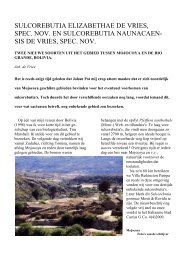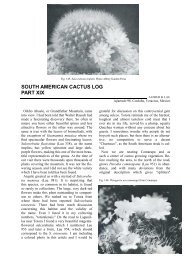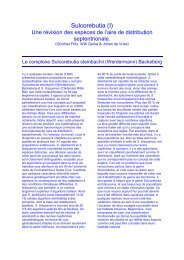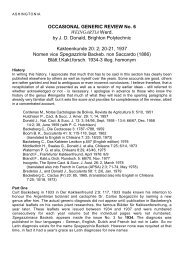Sulcorebutia, food for taxonomists?
Sulcorebutia, food for taxonomists?
Sulcorebutia, food for taxonomists?
Create successful ePaper yourself
Turn your PDF publications into a flip-book with our unique Google optimized e-Paper software.
plants were indeed found in the province of Tucuman.<br />
In 1895 the genus Rebutia was defined by K. Schumann. (Fig 1) Schumann had observed that<br />
the new plant did not bloom from the areole, so it could not be an echinopsis. The plant itself<br />
resembled an echinocactus or malacocarpus, but as the flower originated from outside the<br />
areole, it had to be related to Mamillaria “without any doubt”. The shape of the corolla and<br />
the pericarp however prevented classifying it here. Some years later Schumann withdrew<br />
Rebutia.<br />
28 years later on Spegazzini (1923) defined the genus Aylostera. The decisive feature was a<br />
partial fusion of the style and the tube. Using this characteristic one could clearly distinguish<br />
Aylostera from Rebutia. (Fig 2 and Fig 3)<br />
Fig. 2 Flowersection Rebutia minuscula Fig. 3 Flowersection Aylostera schatzliana JK423<br />
Have the observations of Schumann been checked? I suppose so. Though I was never able to<br />
confirm that Rebutia did not bloom from the areole. But I have heard amateurs discussing<br />
seriously about pistils which had grown together to the tube opposite free pistils.<br />
Berger (1929) did not mention a genus Aylostera. He recognized only one genus Rebutia. He<br />
wrote: “Small pants, roughly globular, reminiscent of mamillaria, with tubercles in spiral rows<br />
and small spines. Flowers from the older areoles, often originating close to the base, small,<br />
funnel-shaped, with slender tube, open by day. These small plants from the mountains are<br />
not to be classified in Echinocactus nor in Echinopsis.”<br />
I have some problems with this statement. Schumann used the observation that the plant did<br />
not bloom from the areole to distinguish the genus. The same characteristic was denied by<br />
Berger. What did he observe instead to be still able to recognize a genus Rebutia,<br />
distinguishable from other genera? We never will know.<br />
Berger mentioned 6 species: Rebutia minuscula, R. deminuta, R. pseudominuscula, R.<br />
pygmaea, R. fiebrigii and R. steinmannii, of these the first four species came from Argentina<br />
and the others from Bolivia.<br />
Does the characteristic, that pistil and tube are partially grown together, make any sense? One<br />
taxonomist will find it important, the other will dismiss it. It was Ritters opinion (1980), that<br />
the fusion hardly had taxonomical meaning, as it would have developed simultaneously in<br />
different separated lines.<br />
Often the characteristic is ignored. How would early <strong>taxonomists</strong> have decided whether a<br />
plant belonged to Rebutia or not? I suspect that plants have been thought to be related after a<br />
rough observation without a real check. Is this strange? No, because such things still happen.<br />
It would be really strange, if one used a <strong>for</strong>mal checklist of characteristics <strong>for</strong> every new plant<br />
to decide to what genus it belongs. The rough and ready approach is a natural way of acting,<br />
but of course it contains the risk of overlooking a significant characteristic.







